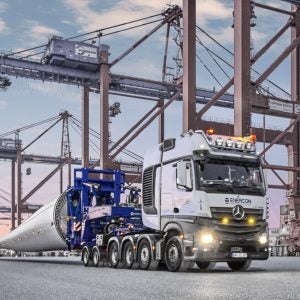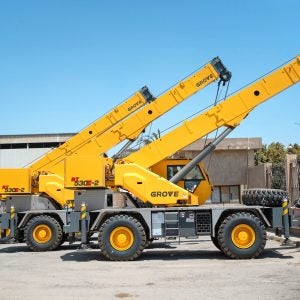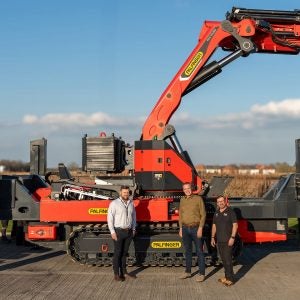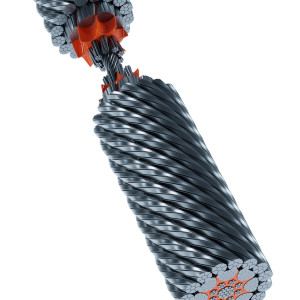The new crane has been designed to replace the highly popular 100t GMK 5100, the last of which left the factory a few months ago. It has a maximum capacity of 110t, and a five-section 51m boom, with an 18m swingaway jib. Two 8m boom extensions give a maximum tip height of 87m. Maximum outreach is 46m The new crane has an improved load chart compared to the old GMK 5100: where the older crane could lift 12t at maximum extension, the new crane can lift 16t.
The crane was designed using Manitowoc’s new modular concept, which sees components shared between different cranes in similar capacity ranges. The project leader for the GMK 5110-1, engineering services manager Andreas Rode, explained that the use of common components had allowed his team to cut the development time for the crane to just seven months. The modular concept has also helped the company’s implementation of lean manufacturing at Wilhelmshaven.
The crane is now the fifth five axle all terrain in production by the company. Speaking at a press conference after the launch, Frans Vanwinkel, senior vice president of sales and marketing, EMEA, said, “When Manitowoc bought Grove, it had seven machines with between two and seven axles. At that time, it was lagging the competition. In five axles, it has now gone one step further. It now has general five axle cranes, and specific models for different markets and regulatory environments. The 5100 had high demand in Africa and the Middle East. The revamped model will be aimed at those markets.”
Component availability allowed for change, so Manitowoc took the opportunity to revamp the 5100.
Opening the presentation, Manitowoc executive vice president for the EMEA region, Phillipe Cohet, said that the company has made ‘a lot of changes – more cranes, shorter delays, more reliable order times’. He explained that one of the first challenges to development is relative to suppliers. Wilhelmshaven is an assembly factory, and supply is a constant problem, Cohet said. “The problem isn’t just changes in the cost of materials, but that cranes are a very specialist product, that need specialist suppliers. The challenge is to develop new suppliers.”
Manitowoc has expanded manufacturing capacity. A new assembly hall is being built at Wilhelmshaven, for turntables and booms. It has moved three and four axle cranes to Niella Tanaro, and Cohet said that capacity at that plant has doubled. The company is implementing lean manufacturing at Wilhelmshaven. It has installed a new production line for the GTK 1100 close to the main plant, and added a new final assembly area at the Wilhelmshaven plant.
The company has developed a completely new international purchasing team. It significantly improved quality control, Cohet said, and increased staffing levels in this department. It has introduced a new quality control stage on the carrier, before final assembly.
Manitowoc has built a new handover area at Wilhelmshaven. Crane drivers can now pick up their crane directly, get informations on options, and training on their new crane.
Talking at a press conference after the launch, Cohet, Vanwinkel and worldwide vice president of marketing Robert Hund discussed supply problems, likely new products, and the state of the market.
Cohet talked about the supply problem in more detail: “The challenge is to convince suppliers that the market will remain strong. They’re often family businesses, and very cautious about risk. Some won’t invest in new capacity, and we have to develop new suppliers. This is a key reason why meeting demand is a problem.”
Vanwinkel said, “The $64,000 question is when the market for all terrains will reach its peak.” Hund said, “We’re developed new models to predict peaks and troughs. Infrastructure and energy are still strong. We’re investing in capacity, and we’re not doing that in a naïve way. We’ve launched 15 or 16 new products, and we’ve got a full development pipeline. Our deals in India, our two Chinese deals, indicate that we’re a global company. Our marketing is directed to this, not just to making regional products.”
Talking about the company’s two Chinese businesses, Cohet said, “We differentiate on performance and reliability, not necessarily on cost. But, by being in China, we be able to work in that cost structure.” Hund added, “The focus in China is more on bringing up the standard in the Chinese market.”
Pressed on new models, Vanwinkel said, “It’s a logical consequence [of the evolution of the company’s product range] that the next step will be a new six axle, but going into details, being concrete, is difficult.” Cohet added, “IPD [Manitowoc’s integrated product development process] is a very structured process. We have been talking to customers, but it could be 2009, 2010, 2011 before a new crane is launched.”
The company was more forthcoming on the likelihood of new products at the lower end of the capacity scale. Asked about new small and simple truck cranes, Vanwinkel said, “We’re looking at the 35t market. There may be something, maybe a small all terrain, maybe a truck mounted crane, in the coming months.”






